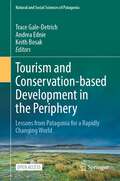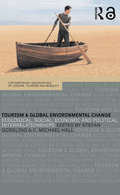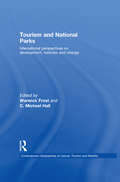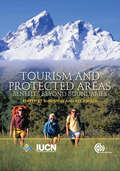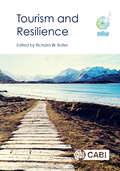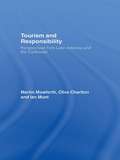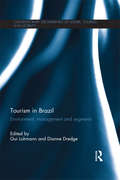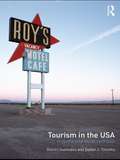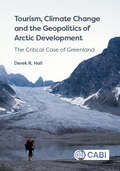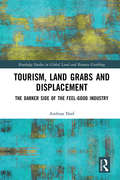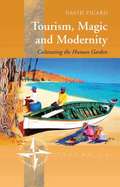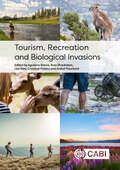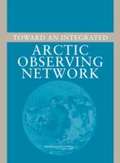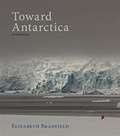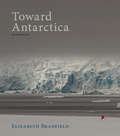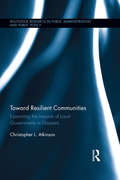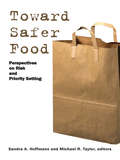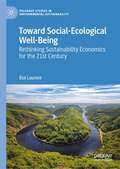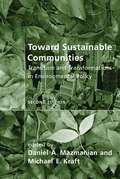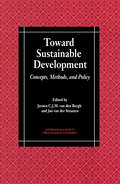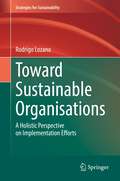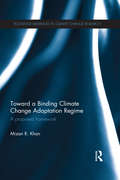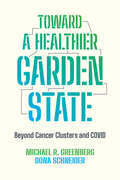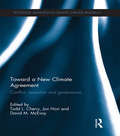- Table View
- List View
Tourism and Conservation-based Development in the Periphery: Lessons from Patagonia for a Rapidly Changing World (Natural and Social Sciences of Patagonia)
by Keith Bosak Trace Gale-Detrich Andrea EdnieThis open access book applies a social ecological systems (SES) lens to conservation-based development in Patagonia, bringing together authors with historical, contemporary, and future-oriented perspectives in order to increase understanding of the social and environmental implications of nature-based tourism and other forms of conservation-based territorial development. By focusing on Patagonia (as a region) and its various forms of conservation-based development, this book contributes one of the first collections of South American based lessons and will be valuable to researchers and practitioners, both locally and around the world, seeking to better understand complex interconnections between social and ecological environments, and pursue a similar path to resilience and sustainability.
Tourism and Global Environmental Change: Ecological, Economic, Social and Political Interrelationships (Contemporary Geographies of Leisure, Tourism and Mobility)
by C. Michael Hall Stefan GösslingThis fascinating book is the first comprehensive analysis of the economic, social and political interrelationships between tourism and global environmental change: one of the most significant issues facing humankind today. Its contributors argue that the impacts of these changes are potentially extremely serious both for the tourism industry, and for the communities dependent upon it. Integrating knowledge from the social and physical sciences, this significant book explores they key issues surrounding global environmental change, as well as government and industry willingness to meet the challenges posed by it. Divided into four main sections, it investigates: the tourism and global environmental change relationship in specific environments global issues related to environmental change differing perceptions of global environmental change held by tourists and the tourist industry. Comprehensive in scope, topical and integrative, this key text is essential reading for students, scholars and researchers in all aspects of tourism, geography and environmental studies.
Tourism and National Parks: International Perspectives on Development, Histories and Change (Contemporary Geographies of Leisure, Tourism and Mobility)
by Warwick Frost C. Michael HallIn 1872 Yellowstone was established as a National Park. The name caught the public’s imagination and by the close of the century, other National Parks had been declared, not only in the USA, but also in Australia, Canada, and New Zealand. Yet as it has spread, the concept has evolved and diversified. In the absence of any international controlling body, individual countries have been free to adapt the concept for their own physical, social and economic environments. Some have established national parks to protect scenery, others to protect ecosystems or wildlife. Tourism has also been a fundamental component of the national parks concept from the beginning and predates ecological justifications for national park establishment though it has been closely related to landscape conservation rationales at the outset. Approaches to tourism and visitor management have varied. Some have stripped their parks of signs of human settlement, while increasingly others are blending natural and cultural heritage, and reflecting national identities. This edited volume explores in detail, the origins and multiple meanings of National Parks and their relationship to tourism in a variety of national contexts. It consists of a series of introductory overview chapters followed by case study chapters from around the world including insights from the US, Canada, Australia, UK, Spain, France, Sweden, Indonesia, China and Southern Africa. Taking a global comparative approach, this book examines how and why national parks have spread and evolved, how they have been fashioned and used, and the integral role of tourism within national parks. The volume’s focus on the long standing connection between tourism and national parks; and the changing concept of national parks over time and space give the book a distinct niche in the national parks and tourism literature. The volume is expected to contribute not only to tourism and national park studies at the upper level undergraduate and graduate levels but also to courses in international and comparative environmental history, conservation studies, and outdoor recreation management.
Tourism and Protected Areas: Benefits Beyond Boundaries
by Robyn Bushell Paul EaglesBringing together the diverse experiences of park agencies and managers, conservation NGO's and international agencies this book examines the role of tourism in protected area management.
Tourism and Resilience
by Richard W. ButlerThis is the first book to address the concept of resilience and its specific application and relevance to tourism, in particular tourism destinations. Resilience relates to the ability of organisms, communities, ecosystems and populations to withstand the impacts of external forces while retaining their integrity and ability to continue functioning. It is particularly applicable to tourism destinations and attractions which are exposed to the potentially harmful and sometimes severe effects of tourism development and visitation, but which also can experience increased resilience from the economic benefits of tourism. Phenomena such as destination communities, wildlife populations and ecosystems are discussed, as well as the ability of places and communities to use tourism and its infrastructure to recover from disasters such as tsunamis, earthquakes, unrest and disease. This book: #65533; Compares the relevance of resilience to sustainability #65533; Contains contributions from many of the leading international authors #65533; Brings together varying viewpoints of both conceptual and applied issues #65533; Includes example case studies from Whistler, western Canada; Sri Lanka; Purnululu National Park, Australia; and the remote Pitcairn Island in the Pacific Tourism and Resilience is relevant for researchers, students and practitioners in tourism and related fields such as development studies, geography, sociology, anthropology, economics and business/management.
Tourism and Responsibility: Perspectives from Latin America and the Caribbean
by Ian Munt Martin Mowforth Clive CharltonThis book discusses the responsibility, or otherwise, of tourism activities in Latin America and the Caribbean. It considers issues such as the reduction of poverty through tourism and the conflict between increasing volumes of air travel spent in our continuing search for pleasure and the resulting contribution to global warming. The authors believe that tourism can only be adequately assessed through a consideration of how it fits into the structure of power. It is also argued that tourism cannot be analyzed without a consideration of its impacts on and links with development. This relationship between tourism, responsibility, power and development is explored in chapters covering both the macro and the micro level of responsibility. The authors look at methods of practising tourism responsibly or irresponsibly at the personal, company, national and international levels. The questions and dilemmas of "placing" responsibility in the tourism industry are examined throughout. Widely illustrating all these themes and issues with examples and case studies from throughout the sub-continent, this book will be of importance to students and academics and to the work of practitioners of development and tourism-related projects run by both governmental and non-governmental aid and development agencies.
Tourism in Brazil: Environment, Management and Segments (Contemporary Geographies of Leisure, Tourism and Mobility)
by Gui Lohmann Dianne DredgeSince the 1990s, tourism has become a major driver of economic activity and community development in Brazil. New policies and approaches, growing expertise and investment in tourism have brought significant transformation in tourism products, destination development and community involvement. In addition Brazil will be hosting two major sport events in the years ahead, i.e. the Soccer World Cup, in 2014, and the Olympic Games in Rio de Janeiro, in 2016. Brazil offers many cultural and natural attractions but, similar to many other developing countries, it still struggles with issues such as infrastructure, accessibility, product development, service quality, market access and workforce training. This book provides an in-depth examination of tourism in Brazil, critically reviewing its development and management. The social, economic, political and environmental contexts of this emerging global power provide an intriguing backdrop. The book considers important development issues such as the changing policy context, community benefit tourism and indigenous tourism. It explores the impacts of tourism on the environment, changing community attitudes towards tourism, transport infrastructure and sustainability issues in events. Particular segments are explored including backpacker tourism, sensual tourism, adventure tourism and ecotourism and the implications for tourism research and education are examined. The book draws from theoretical foundations and practical insights, and gives voice to Brazilian researchers who are actively engaged in researching tourism. Drawing from cutting edge cross-cultural research, this original and timely book will be of interest to students, researchers and academics in the areas of Tourism, Geography and related disciplines.
Tourism in the USA: A Spatial and Social Synthesis
by Dimitri Ioannides Dallen TimothyThe United States continues to provide opportunities for travel and tourism to domestic and international travellers. This is the first book to offer students a comprehensive overview of both tourism and travel in this region, paying specific attention to the disciplines of Geography, Tourism Studies and, more generally, Social Science. Tourism in the USA explains the evolution of tourism paying attention to the forces that shaped the product that exists today. The focus of the book includes the manner in which tourism has played out in various contexts; the role of federal, state, and local policy is also examined in terms of the effects it has had on the US travel industry and on destinations. The various elements of tourism demand and supply are discussed and the influence that transportation (especially Americans’ high personal mobility rates and love affair with the auto) has had on the sector highlighted. The economics of tourism are fleshed out before focusing more narrowly on both the urban and rural settings where tourism occurs. A look into the manner in which the spatial structure of cities is transformed through tourism is also offered. Additionally, a brief examination of future issues in American tourism is presented along with explanations concerning the ascendancy of tourism as an economic development tool in various areas. The book combines theory and practice as well as integrating a range of useful student orientated resources to aid understanding and spur further debate, which can be used for independent study or in class exercises. These include: ‘Closer Look’ case studies with reflective questions to help show theory in practice and encourage critical thinking about tourism developments in this region ‘Discussion Questions’ at the end of each chapter encourage stimulating debates ‘Further Reading’ sections direct the readers to related book and web resources so that they can learn more about the topics covered in each chapter. Written in an engaging style and supported with visual aids, this book will provide students globally with an in-depth and essential understanding of the complexities of tourism and travel in the USA.
Tourism, Climate Change and the Geopolitics of Arctic Development: The Critical Case of Greenland
by Derek HallGreenland is becoming a critically important territory in terms of tourism, climate change and competition for resource access, yet it has been poorly represented in academic literature. Tourism now features as a major source of income for the territory alongside fisheries. Cruise tourism is increasing rapidly, and might superficially appear to be best suited to Greenlandic conditions, given the lack of large-scale accommodation infrastructure and almost non-existent land routes between settlements. Ironically, one of the most spectacular tourist attractions is the large number of icebergs that are being calved as the result of glacier retreat and ice cap melting, both appearing to be taking place at ever increasing rates. As a consequence of ice removal, the territory's claimed extensive range of mineral resources, not least rare earth elements and hydrocarbons, are becoming more accessible for exploitation and, thereby, are acting increasingly as the focus for geopolitical competition. This book explores the nature of dynamics between tourism, climate change and the geopolitics of natural resource exploitation in the Arctic and examines their interrelationships specifically in the critical context of Greenland, but within a framework that emphasises the wider global implications of the outcomes of such interrelationships. This book is the first to explore these interrelationships in depth in English.
Tourism, Land Grabs and Displacement: The Darker Side of the Feel-Good Industry (Routledge Studies in Global Land and Resource Grabbing)
by Andreas NeefThis book examines the global scope of tourism-related grabbing of land and other natural resources. Tourism is often presented as a peaceful and benevolent sector that brings people from different cultural backgrounds together and contributes to employment, poverty alleviation, and global sustainable development. This book sheds light on the lesser known and much darker side of tourism as it unfolds in the Global South. While there is no doubt that tourism has been an engine of economic growth for many so-called developing countries, this has often come at the cost of widespread dispossession and displacement of Indigenous and non-indigenous communities. In many countries of the Global South, tourism development is increasingly prioritised by governments, businesses, international financial institutions and donors over the legitimate land and resource rights of local people. This book examines the actors, drivers, mechanisms, discourses and impacts of tourism-related land grabbing and displacement, drawing on more than thirty case studies from Latin America and the Caribbean, sub-Saharan Africa, South and Southeast Asia, the Middle East and the Southwest Pacific. The book provides solid grounds for an informed debate on how different actors are responsible for the adverse impacts of tourism on land rights infringements, what forms of resistance have been deployed against tourism-related land grabs and displacement, and how those who have violated local land and resource rights can be held accountable. Tourism, Land Grabs and Displacement will be essential reading for students and scholars of land and resource grabbing, tourism studies, development studies and sustainable development more broadly, as well as policymakers and practitioners working in those fields.
Tourism, Magic And Modernity
by David PicardDrawing from extended fieldwork in La Réunion, in the Indian Ocean, the author suggests an innovative re-reading of different concepts of magic that emerge in the global cultural economics of tourism. Following the making and unmaking of the tropical island tourism destination of La Réunion, he demonstrates how destinations are transformed into magical pleasure gardens in which human life is cultivated for tourist consumption. Like a gardener would cultivate flowers, local development policy, nature conservation, and museum initiatives dramatise local social life so as to evoke modernist paradigms of time, beauty and nature. Islanders who live in this 'human garden' are thus placed in the ambivalent role of 'human flowers', embodying ideas of authenticity and biblical innocence, but also of history and social life in perpetual creolisation.
Tourism, Recreation and Biological Invasions
by Agustina Barros, Ross Shackleton, Lisa J. Rew, Cristóbal Pizarro and Aníbal PauchardThe first section of the book includes information about how tourism-related infrastructure and activities promote biological invasions, including key pathways for non-native invasive species introductions. This section provides case studies of different organisms that are known to be introduced and/or promoted by tourism in different ecosystems or regions. The second section elaborates on known and potential impacts of invasive species on tourism and recreation, including how they may affect, positively or negatively, the economic revenue from tourism, tourist access, recreation, aesthetic values and tourists' perceptions. The last section focuses on management and policy, covering aspects of how visitors perceive invasive species and their willingness to manage them, biosecurity measures to prevent invasion related to tourism, as well as potential policy options moving forward. The book draws on a number of examples across multiple taxa, landscapes and regions of the world.
Tow Truck Joe Makes a Splash (Tow Truck Joe)
by June SobelBrimming with catchy rhymes, bright colors, and summer fun, this sequel to Tow Truck Joe will delight fans of the original and new readers alike! A delightful rhyming picture book from the author of The Goodnight Train.One for all! All for one!We can fix it! Let&’s have fun! It&’s a hot summer day in Motor City and Joe the Tow and Patch the Pup are very busy! When a back-up at the Splash &’n&’ Shine car wash causes a delay, Patch and Joe need help from their friends to save the day. There&’s no job too big for the Motor City friends when they work together!
Toward An Integrated Arctic Observing Network
by National Research Council of the National AcademiesObservable changes with regional and global implications, such as warming temperatures and reduced sea ice, are taking place across the Arctic. However, the record of Arctic observations suffers from incomplete geographic coverage and limited duration, and measurements are not well coordinated. This makes it difficult to comprehensively describe current conditions in the Arctic, let alone understand the changes that are underway or their connections to the rest of the Earth system. The U.S. National Science Foundation asked for guidance to help design a pan-arctic observing network. This book outlines the potential scope, composition, and implementation strategy for an arctic observing network. Such an integrated, complete, and multidisciplinary environmental observing network will improve society's understanding of and ability to respond to ongoing systemic changes in the Arctic and its capability to anticipate, predict, and respond to future change both in the Arctic and around the globe. The network would build on and enhance existing national and international efforts and deliver easily accessible, complete, reliable, timely, long-term, pan-arctic observations. Because many potential components of the network already exist or are being planned, and because of the surge of activity during the International Polar Year, there is an immediate opportunity for major progress.
Toward Antarctica
by Elizabeth BradfieldPoet-naturalist Elizabeth Bradfield's fourth collection, Toward Antarctica, documents and queries her work as a guide on ships in Antarctica, offering an incisive insider's vision that challenges traditional tropes of The Last Continent. Inspired by haibun, a stylistic form of Japanese poetry invented by 17th-century poet, Matsuo Bashō to chronicle his journeys in remote Japan, Bradfield uses photographs, compressed prose, and short poems to examine our relationship to remoteness, discovery, expertise, awe, labor, temporary societies, "pure" landscapes, and tourism's service economy. Antarctica was the focus of Bradfield's Approaching Ice, written before she had set foot on the continent; now Toward Antarctica furthers her investigation with boots on the ground. A complicated love letter, Toward Antarctica offers a unique view of one of the world's most iconic wild places.
Toward Antarctica: An Exploration
by Elizabeth Bradfield“The most original piece of travel writing about the Antarctic region I have read in years . . . Bradfield is a literary tour guide in the best sense.” —Elizabeth Leane, author of Antarctica in Fiction: Imaginative Narratives of the Far SouthA poet and a naturalist, Elizabeth Bradfield documents and examines her work as a guide on ships in Antarctica through poetry, prose, and photographs, offering an incisive insider’s vision that challenges traditional tropes of The Last Continent.Inspired by haibun, a stylistic form of Japanese poetry invented by seventeenth-century poet Matsuo Basho to chronicle his journeys in remote Japan, Bradfield uses photographs, compressed prose, and short poems to examine our relationship to remoteness, discovery, expertise, awe, labor, temporary societies, “pure” landscapes, and tourism’s service economy. Antarctica was the focus of Bradfield’s Approaching Ice, written before she had set foot on the continent; now Toward Antarctica furthers her investigation with boots on the ground. A complicated love letter, Toward Antarctica offers a unique view of one of the world’s most iconic wild places.Like having a poet’s behind-the-scenes tour of a natural history museum . . . the exquisite landscape and wildlife come into vivid view; so does the gutsy work and responsibility of being a naturalist guide.” —Alison Hawthorne Deming, author of Zoologies: On Animals and the Human Spirit
Toward Resilient Communities: Examining the Impacts of Local Governments in Disasters (Routledge Research in Public Administration and Public Policy)
by Christopher L. AtkinsonIn June 2011, the city of Minot, North Dakota sustained the greatest flood in its history. Rather than buckling under the immense weight of the flood on a personal and community level, government, civic groups, and citizens began to immediately assess and address the event’s impacts. Why did the disaster in Minot lead to government and community resilience, whereas during Hurricane Katrina, the non-resilience of the government and community of New Orleans resulted in widespread devastation? This book seeks to answer that question by examining how local government institutions affect pre- and post-disaster community and business resilience. Utilizing both survey methods and interviews, Atkinson analyzes the disasters that occurred in New Orleans, Louisiana, Palm Beach County, Florida, and Minot, North Dakota. He argues that institutional culture within local government impacts not only the immediate outcomes experienced during response, but the long-term prognosis of recovery for a community outside the walls of city hall. Understanding tendencies within a community that lead to increased vulnerability of both individuals and businesses can lead to shifts in governmental/community priorities, and potentially to improved resilience in the face of hazard events. Relevant to scholars of public administration, disaster researchers, and government officials, this book contributes to a growing literature on community and business resilience. It explores not just the devastation of natural disasters, but profiles governmental impacts that led to responsive and able processes in the face of disaster.
Toward Safer Food: Perspectives on Risk and Priority Setting
by Sandra Professor Hoffmann Michael R. TaylorIn 1998, a National Academy of Sciences panel called for an integrated, risk-based food safety system. This goal is widely embraced, but there has been little advance in thinking about how to integrate knowledge about food safety risks into a system- wide risk analysis framework. Such a framework is the essential scientific basis for better priority setting and resource allocation to improve food safety. Sandra Hoffmann and Michael Taylor bring together leading scientists, risk analysts, and economists, as well as experienced regulators and policy analysts, to better define the priority setting problem and focus on the scientific and intellectual resources available to construct a risk analysis framework for improving food safety. Toward Safer Food provides a common starting point for discussions about how to construct this framework. The book includes a multi-disciplinary introduction to the existing data, research, and methodological and conceptual approaches on which a system-wide risk analysis framework must draw. It also recognizes that efforts to improve food safety will be influenced by the current institutional context, and provides an overview of the ways in which food safety law and administration affect priority setting. Hoffman and Taylor intend their book to be accessible to people from a wide variety of backgrounds. At the same time, they retain the core conceptual sophistication needed to understand the challenges that are inherent in improving food safety. The editors hope that this book will help the U.S. move beyond a call for an integrated, risk-based system toward its actual construction.
Toward Social-Ecological Well-Being: Rethinking Sustainability Economics for the 21st Century (Palgrave Studies in Environmental Sustainability)
by Éloi LaurentThis book investigates the deep economic causes of environmental unsustainability and offers a new vision to rebuild sustainability economics. While sustainability scholars are hard at work with documenting the tangible systemic crisis of our Biosphere, the economic roots of this crisis are rarely exposed, examined nor addressed. This book’s central contribution to sustainability studies is to argue that what we should sustain is not economic growth but social-ecological well-being defined as a combination of planetary health, cooperation and justice resulting in human holistic prosperity. The long-term prosperity of humanity indeed relies on generating health and fostering cooperation informed by justice: social-ecological well-being should be the cornerstone of sustainability economics for the 21st century. Within this framework, this book attempts to explain why the three key dimensions of sustainability are jointly in crisis, show what vision can articulate those dimensions to rethink sustainability economics for our century, what practical policies should be undertaken to give life to these visions before concluding on the need to reinvent the narratives that sustain economic analysis.
Toward Sustainable Communities: Transition and Transformations in Environmental Policy (American and Comparative Environmental Policy)
by Michael E. Kraft Daniel A. Mazmanian D. Mazmanian<p>A new edition with new and updated case studies and analysis that demonstrate the trend in U.S. environmental policy toward sustainability at local and regional levels. <p>This analysis of U.S. environmental policy offers a conceptual framework that serves as a valuable roadmap to the array of laws, programs, and approaches developed over the last four decades. Combining case studies and theoretical discussion, the book views environmental policy in the context of three epochs: the rise of command-and-control federal regulation in the 1970s, the period of efficiency-based reform efforts that followed, and the more recent trend toward sustainable development and integrated approaches at local and regional levels. It assesses the strengths and weaknesses of the new approaches and places these experiments within the larger framework of an emerging trend toward community sustainability. <p>Toward Sustainable Communities assesses environmental policy successes and failures at the subnational, regional, and state levels and offers eight case studies of policy arenas in which transformations have been occurring―from air and water pollution control and state and local climate change policy to open space preservation, urban growth, and regional ecosystem management. It discusses the various meanings of sustainability and whether the concept can serve as a foundation for a new era of environmental policy. The second edition has been substantially updated, with five new chapters (including the chapter on climate change) and all other chapters revised and shortened. It is suitable as a primary or secondary text for environmental policy courses and as a resource for scholars and policymakers.</p>
Toward Sustainable Development: Concepts, Methods, and Policy (Intl Society for Ecological Economics)
by International Society for Ecological Economics Jan van der Straaten Jeroen C.J.M. van den BerghToward Sustainable Development is a comprehensive and wide ranging exploration of the theoretical and practical aspects of the concept of sustainable development. Internationally known scholars present an in depth critique of traditional economic methods and ideas, and a new framework for analysis of issues of development and environmental policy. The book: outlines the historical development of the concept of sustainable developmentclarifies the many interpretations of what sustainable development ispresents new and detailed assessments of the concepts, methods, and implementation of sustainable development policiesAs well as explaining the conceptual and theoretical background, the book discusses methods and techniques, and examines issues of policy and implementation. It offers both critical observations on old approaches, and valuable guidelines for recent innovations.
Toward Sustainable Organisations: A Holistic Perspective on Implementation Efforts (Strategies for Sustainability)
by Rodrigo LozanoThe book is one of the first ones focussing on how organisations (civil society, corporations, and public sector ones) are contributing to sustainability. The book starts by providing a discussion of the four dimensions of sustainability (economic, environmental, social, and time). The second chapter focusses on what organisations are, their system elements (e.g. operations and production, management and strategy, and governance), stakeholders, relationships within and between organisations (ranging from competition to collaboration), and a framework for organisations to understand and map how they can contribute to sustainability. The third chapter discusses the twenty-four main tools, initiatives, and approaches (TIAs) that have been developed for organisations to contribute to sustainability, such as Circular Economy, Corporate Social Responsibility, Environmental Management Systems, and Sustainability Reporting. The fourth chapter focusses on organisational change management for sustainability, including types of change, drivers for change, resistance to change, incorporation, and institutionalisation. The fifth chapter presents empirical evidence on what civil society organisations have contributed to sustainability, from priorities and impacts, TIAs, external stimuli, and internal factors, drivers for change, starts of change, and development of change. The sixth chapter presents empirical evidence on what corporations have contributed to sustainability, from priorities and impacts, TIAs, external stimuli, and internal factors, drivers for change, starts of change, and development of change. The seventh chapter presents empirical evidence on what public sector organisations have contributed to sustainability, from priorities and impacts, TIAs, external stimuli, and internal factors, drivers for change, starts of change, and development of change. The last chapter provides the conclusions of the book.The book is aimed at providing a multi-level, dynamic, and holistic perspective on the contributions of organisations to sustainability. The book's uniqueness lies in analysing organisations’ efforts to become more sustainability oriented and contribute to making societies more sustainable through systems thinking, TIAs, and change processes.
Toward a Binding Climate Change Adaptation Regime: A Proposed Framework (Routledge Advances in Climate Change Research)
by Mizan R. KhanFirst published in 2014. Routledge is an imprint of Taylor & Francis, an informa company.
Toward a Healthier Garden State: Beyond Cancer Clusters and COVID
by Michael R. Greenberg Dona SchneiderWhile New Jersey now frequently appears near the top in listings of America’s healthiest states, this has not always been the case. The fluctuations in the state’s overall levels of health have less to do with the lifestyle choices of individual residents and more to do with broader structural issues, ranging from pollution to urban design to the consolidation of the health care industry. This book uses the past fifty years of New Jersey history as a case study to illustrate just how much public policy decisions and other upstream factors can affect the health of a state’s citizens. It reveals how economic and racial disparities in health care were exacerbated by bad policies regarding everything from zoning to education to environmental regulation. The study further chronicles how New Jersey struggled to deal with public health crises like the AIDS epidemic and the crack epidemic. Yet it also explores how the state has developed some of the nation’s most innovative responses to public health challenges, and then provides policy suggestions for how we might build an even healthier New Jersey.
Toward a New Climate Agreement: Conflict, Resolution and Governance (Routledge Advances in Climate Change Research)
by Jon Hovi David M. McEvoy Todd L. CherryClimate change is one of the most pressing problems facing the global community. Although most states agree that climate change is occurring and is at least partly the result of humans’ reliance on fossil fuels, managing a changing global climate is a formidable challenge. Underlying this challenge is the fact that states are sovereign, governed by their own laws and regulations. Sovereignty requires that states address global problems such as climate change on a voluntary basis, by negotiating international agreements. Despite a consensus on the need for global action, many questions remain concerning how a meaningful international climate agreement can be realized. This book brings together leading experts to speak to such questions and to offer promising ideas for the path toward a new climate agreement. Organized in three main parts, it examines the potential for meaningful climate cooperation. Part 1 explores sources of conflict that lead to barriers to an effective climate agreement. Part 2 investigates how different processes influence states’ prospects of resolving their differences and of reaching a climate agreement that is more effective than the current Kyoto Protocol. Finally, part 3 focuses on governance issues, including lessons learned from existing institutional structures. The book is unique in that it brings together the voices of experts from many disciplines, such as economics, political science, international law, and natural science. The authors are academics, practitioners, consultants and advisors. Contributions draw on a variety of methods, and include both theoretical and empirical studies. The book should be of interest to scholars and graduate students in the fields of economics, political science, environmental law, natural resources, earth sciences, sustainability, and many others. It is directly relevant for policy makers, stakeholders and climate change negotiators, offering insights into the role of uncertainty, fairness, policy linkage, burden sharing and alternative institutional designs.
